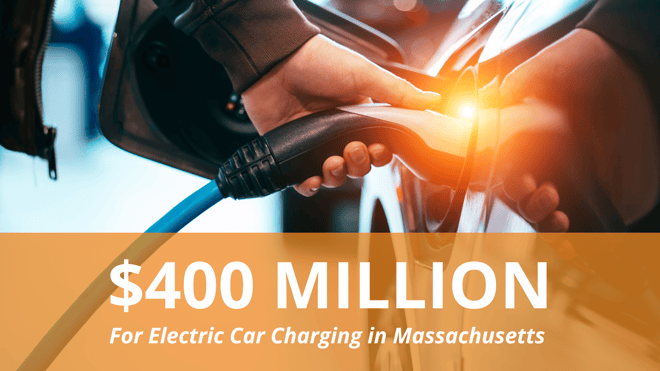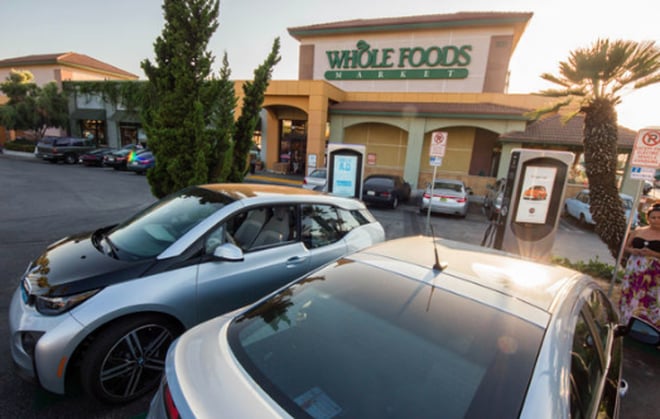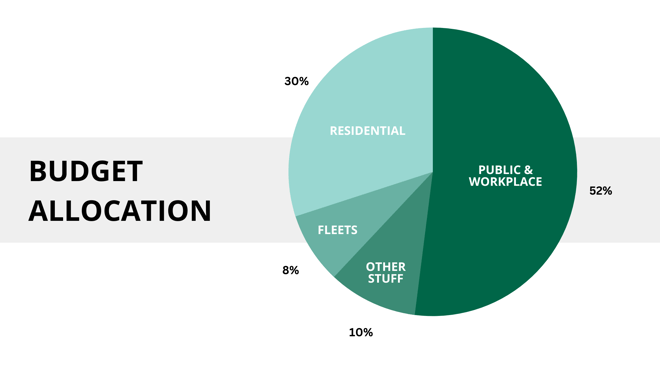Massachusetts Residents: Take Action For Smart Charging Rates for Electric Cars
If you drive an electric car, it matters when you plug in and charge – both in terms of the emissions caused by...

Way back in the summer of 2021, the electric utilities in Massachusetts – Eversource, National Grid, and Unitil – proposed bold new electric vehicle programs to the Department of Public Utilities (DPU). For the next year, the DPU engaged in a formal process to weigh the utilities’ proposals. Green Energy Consumers served as an official “intervenor” in this docket, which means we advocated for what we thought the DPU should approve. Now, finally, a year and a half later, the DPU has issued its order, unleashing hundreds of millions of dollars for electric vehicle charging infrastructure over the next four years via Make Ready programs and rebates for charging installation (those are two separate but complementary things, as we’ll talk about below!).
May 2023 update: The utility programs are now live and taking applications! You can learn more about how much is available in incentives for residential consumers (single family, 2-4 unit buildings, and 5+) and how to apply here on our website.
The term “Make Ready” refers to a type of program where the electric utility pays for work needed on the utility side of the electric meter. That means, for example, if you are a supermarket owner and want to install charging stations but need to lay new conduit, the electric utility would cover the costs of bringing electric service to the charging pad. National Grid and Eversource have both had Make Ready programs in the past, but for some months now, those programs have been fully subscribed. In these dockets, National Grid and Eversource both proposed to expand their Make Ready programs, both in terms of the segments served and in terms of the budget.

In the past, Make Ready was available only for public, workplace, and multi-unit (5+) dwellings. Both electric utilities proposed to offer Make Ready support to 1-4 unit households and fleets. Intervenors like Green Energy Consumers succeeded in convincing the DPU that (a) the Commonwealth must build out charging infrastructure to support the level of EV adoption that is needed to achieve the mandated greenhouse gas emissions reductions by 2030 and (b) that financial incentives like Make Ready will be needed for the next couple of years.
The DPU concludes by saying “the Department approves the Companies’ make-ready rebate proposals” with the exception “that make-ready rebates must not exceed actual make-ready installation costs” (see p. 101 of the final order). Hurray!
The electric utilities also proposed to offer rebates for the other half of the costs to install charging: the actual charging unit and the labor to hook it up to electric service. Here, the DPU had more to say. Basically, the Department set up a sliding scale system where low-income customers or sites in environmental justice communities qualify for higher rebates while customers or sites in other locations qualify for no or lower rebates. The following table summarizes what they approved in each program segment.
| Make Ready Support (Infrastructure Side) | Charging Station Rebates (Customer Side |
|
| Residential: 1-4 unit homes |
Up to 100% of infrastructure costs | Only for customers enrolled in the low-income discount rate and managed charging program; Rebate of up to 100% of EVSE costs (see page 117 of final order) |
| Residential: 5+ unit homes (AKA “multi-unit dwellings”, or MUDs) |
Up to 100% of infrastructure costs | Sliding scale for MUDs in different communities (see page 119 of final order)
|
| Public and workplace | Up to 100% of infrastructure costs |
Only for publicly accessible sites, using MassEVIP’s definition of publicly accessible (see page 119 of final order) Sliding scale based on community location (see page 114 of final order):
|
| Fleets | *Only National Grid*: Up to 100% of infrastructure costs |
|
The combination of incentives means that, in some places and for some customers, the costs of installing charging stations will be completely covered by the utility, through a combination of the Make Ready and charging rebates. In others, they will only be partially covered.
(However, more help should be coming. The state already has its MassEVIP program that offers rebates for public charging installation and 2022’s economic development bill put $50 million into a Charging Infrastructure Deployment Fund, which is an entirely separate pot of money for EV charging. The DPU order instructs the electric utilities to require customers to apply for all available state and federal funding in order to participate in the utilities’ EV program.)
The scope of the expansion is incredible. Previous iterations of Make Ready were funded at the scale of $40 million (Eversource) and $25 million (National Grid). Now, the utilities have gotten the green light for about $400 million over the coming years.
|
Electric Utility |
Approved Funding |
Program Term |
|
Eversource |
$188 million |
4 years |
|
National Grid |
$206 million |
4 years |
|
Unitil |
$1 million |
5 years |
About half of the approved funding for National Grid and Eversource will go to public and workplace charging, with a little less than a third for residential charging and eight percent for fleets.
 The incoming dollars from this order dwarf contributions from other places.
The incoming dollars from this order dwarf contributions from other places.
.png?width=660&height=371&name=EV%20Charging%20Funding%20(in%20millions).png)
Where is this money coming from? The electric utilities will assess a very small fee per kilowatt-hour on customers’ electric bills. The bill impact will be less than $5 annually for the average consumer (see p. 197 of the final order). And all those new EVs that start charging thanks to the new charging stations will all be paying into the system for the electricity they use. In California, EVs have paid more into the electric grid than they have cost, and we can expect a similar dynamic here. So we agree with the DPU that this rate is “just and reasonable.”
Right now, according to the Alternative Fuels Data Center, there are 2,322 public Level II and DC Fast Charging stations in Massachusetts with 5,434 charging ports. That’s already a lot more than most people realize (check out PlugShare to find charging near you!). National Grid estimates that their new EV programs will enable up to 32,000 additional charging ports (~7,000 public/workplace, ~24,000 residential, and 600 fleets). Eversource estimates (3,350 public, 2,750 workplace, 16,000 for 1-4 unit homes, 2,100 for 5+ unit homes). Together, that's about 75,000 new charging stations – that's huge!
The final Clean Energy & Climate Plan for 2025 called for 15,000 public charging stations by 2025. With 2,000 public stations already, 3,500 coming from National Grid (assuming half of the 7,000 public/workplace end up being public), and 3,350 more from Eversource, we'll get to roughly 8,850. Add in the NEVI program and state funds, reaching that 15,000 target is in sight.
If you have been hesitating to replace your gas car with an EV because you haven't seen enough charging infrastructure, please start shopping - over the next four years, we will all see a growing number of stations along highways, at shopping centers, in multi-unit housing, and at workplaces.
Though overall, the order from the DPU is good news, we were disappointed by a couple of the Department’s decisions:
There is more we could say about the 250-page ruling from the DPU, but this blog covers the main highlights. The next step in the process is that the electric utilities have to submit compliance filings that will detail the rules of the approved programs. After that, they can actually set programs up and start offering these resources! Once that happens, we’ll be sure to post again, update our website, and host a webinar. Stay tuned!
In the meantime, we’ll leave you with this thought: the order of operations on this whole process is not conducive to good climate planning. We started off, way back in 2021, with the electric utilities proposing a plan for the utilities. Their ultimate goal is to protect their business, not meet the state’s required emissions reductions. We need to move towards a world where the STATE sets the agenda and makes sure the utilities’ work is in line with our mandate to reduce emissions. Last year’s climate bill set up an intergovernmental council on EV charging infrastructure – that's a good first step. But, as always, there’s more work to be done.
If you drive an electric car, it matters when you plug in and charge – both in terms of the emissions caused by...
On March 14, 2019, Green Energy Consumers held a webinar about upcoming initiatives, programs, and policies...
Comments